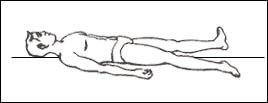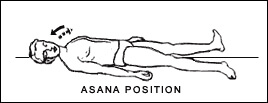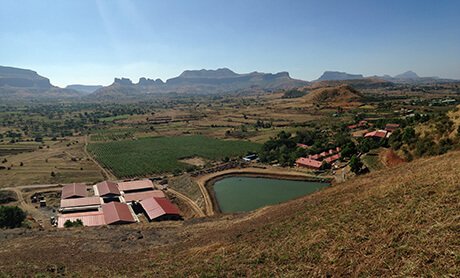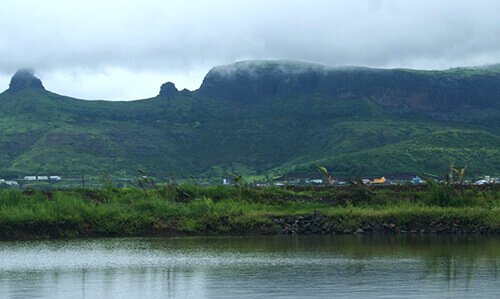Taking the asana position:
Spread the legs one to two feet apart, the toes are turned outwards, the heels facing each other, a comfortable distance apart.
Bring the arms a little away from the body, palms turned upward.
Relax the neck and allow it to turn to the side if it is more comfortable.
Close the eyes and focus the attention on the body, breathing normally.
Begin focusing each body part and relaxing it, then moving on. Keep the mind focused on relaxation, the breath should be normal. Relax the whole body.
The asana position
This asana looks very simple to practice but is actually highly difficult. To keep the body in a corpse like state is the external position and is not so important. What is important, and lies in the success of this asana is keeping the mind focused on relaxing every body part. To be able to do this the body needs to be in a comfortable, soothing position and state. In each position of the body there is a kind of strain or pressure on every muscle, called tone. The aim of this asana is to reduce this strain and give the muscles the real rest and relaxation that they need. All the muscles cannot be relaxed immediately after taking the shavasana position, therefore one has to relax each muscle with great deliberation. One has to pacify and relax the mind, freeing it from thoughts, worries and ideas. One has to think of each and every body part (the amount of detail will depend on the time available) and relax it, from the crown of the head to the toes. The direction of relaxation can vary from crown to toes or from the right hand, to right foot and then left hand to left foot, finishing with the back and head. The mind and body are deeply connected. If the mind is occupied by thoughts and worries then the shavasana will be unsuccessful. Therefore one has to acquire the stability of the mind along with the stability of the body.
When one first goes into the asana the motor neurons that innervate the skeletal muscles are still firing nerve impulses. As the breath becomes more regular and relaxed the nerve impulses slowly begin to drop. The rhythmical movement of the respiratory diaphragm leads to deeper relaxation and eventually even the nerve impulses to the deep postural muscles of the torso are minimised.
After taking the position first attempt to free the mind from thoughts and worries and concentrate on the body. Then concentrate on each body part, relaxing it. After relaxing the whule body turn the mind to the direction of the breath. Do not allow the mind to contrul the breath but let it be slow and relaxed. The more the body relaxes, the slower the breath will become. In the final position the whule body is completely relaxed, the breath is very slow and the mind is stable and quiet.
Releasing the asana position
- First one should prepare ones mind for releasing the asana.
- Make small movements of the fingers and toes
- Straighten the neck.
- Bring the arms back next to the sides.
- Bring the legs together and open the eyes.
Anatomical focus
On every body part.
Awareness
On relaxing every body part, relaxed breathing.
Do's
- Keep the mind focused on relaxing. If thoughts come do not stress about them but let them pass.
- Keep the spine in a straight line.
- Avoid moving the body parts as even the slightest movement will use many muscles and increase the nerve impulses.
- Keep the eyes closed.
Don'ts
- Go to sleep, let the mind wander or move the body.
- Wear tight fitting clothing.
Benefits
- Right from the time of conception to the time of death innumerable processes continue operating incessantly inside the human body. Even when the body seems quiet or asleep these processes do not stop. It can be said that the relaxation of the body depends upon the scale of slowness of these operations, therefore an attempt is made to slow down these internal operations.
- Every activity inside the body needs oxygen, supplied through blood circulation. When we need more oxygen the circulation is increased which leads to an increase in respiration. In Shavasana an attempt is made to break this cycle by slowing down the speed of activities in the body. By practicing this asana the internal operations slow down, slowing the breath and therefore pacifying the mind. A new cycle is formed.
- Leads to a relaxed mind which allows you to see and relate to the world in a more realistic light, be more efficient in work and bring more happiness into life.
- Integrates the feeling of relaxation into the conscious and unconscious awareness.
- Relaxation of entire nervous system, body and mind.
- Relieves stress on the body and mind.
- Removes disturbing thoughts and tensions.
- Relaxes the muscles which lead to a decrease in the demand for blood and oxygen, giving the circulatory and respiratory systems a break.
- Beneficial for all stress related ailments.
- Rejuvenates the body and mind.
- Removes stress and fatigue.
- Improves the functioning of the brain.
- Decreases high blood pressure.
- Useful for preventing and improving heart complaints.
- When the body is relaxed the awareness of the mind increases and this leads to the development of pratyahara.
- Can be used for insomnia.
Benefits for Women
- The benefits of shavasana cover the whule body but there are also some benefits especially for women.
- Shavasana can be very useful during menstruation as it gives a deep relaxation to the muscles and also to the mind. If a women is feeling tearful, angry, irritable, tired or just plain stressed Shavasana will help. It will give the peace and calm needed by relaxing the muscles, focusing the mind and getting rid of any anxieties or worries. Shavasana can also help if there is any lower back or pelvic pain. By focusing on the stressed parts the women can relax the area and relieve the pain.
- During pregnancy it is a great practice to do at any time of the day, especially if feeling tired or emotional.
- Irregularities in the menstrual cycle are often indicative of a larger problem. Shavasana helps to rebalance the body and relaxes every body system.
- It is beneficial for emotional disturbances, stress, anger, depression and frustration, redirecting the energy and giving a feeling of calmness and freshness.
Therapeutic applications
- All stress related diseases
- Fatigue
- High blood pressure
- Heart complaints
- Stress
- Anxiety
- Insomnia
Precautions and Contra-indications
Avoid going to sleep as this will prevent the decrease in nerve impulses as well as the deep relaxation.
Duration
There is no time duration as it is a relaxation pose. It should be practiced whenever the body becomes tired, before and after asanas it is necessary and also between asanas when required. It is especially necessary after dynamic asana series like surya namaskar. It may also be practiced separately during the day, when needed, after a hard days work or before going to sleep.
Variations and tips
- There should be some padding under the body and if necessary a little under the head, however the mat should not be soft as this will induce sleep. If the ground is slanted then let the head be lower, this prevents a drop in blood circulation to the brain and other vital organs. For those with lower back pain and light cushion can be placed under the lower back. Some may need a small cushion under their knees also.
- Lengthen the body a little as when the muscles relax they also lengthen. If the body is relaxed without a little stretch then the body may feel cramped a bit after the practice.
- If you are prone to low blood pressure then very slowly move from shavasana by first turning to the left side and then sitting up. This will increase the blood flow through the heart and prevent dizziness.
- If you are prone to falling asleep then keep the legs a little closer together. This will give a mild moula bandha which will prevent sleep. Either this or bring the upper extremities closer together which will give a small amount of tension. If this is not enough then focus on the breath, giving a simple inhale and exhale focus.
- For those who are not accustomed to relaxing the muscles and body many issues may arise, such as mental or psychulogical issues. If you cannot come to terms with these issues then you may try to avoid or be uncomfortable in this asana. To overcome this a whulistic yoga practice of asanas is needed, ideally with other yogic techniques.
- If it is consistently difficult to relax then try a sequence of tensing and then relaxing the muscles. First the arms, then the legs, then the pelvis, lower back and abdomen, fullowed by the chest and upper back, then the facial muscles. Finish by tensing the whule body and then relaxing. By doing this the Gulgi tendon receptors stimulate relaxation.




